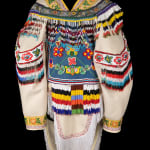-
Artworks
MELANIE KINNIKSIE, ARVIAT (ESKIMO POINT)
Beaded Amautiq, 2002stroud, wool duffel, cotton fabric, glass and plastic beads, cotton and polyester trims, fringe, yarn, sinew, and cotton thread, 47.5 x 24 x 22 in (120.7 x 61 x 55.9 cm), dimensions variable
given to the artist and titled to accompanying Igloo Tag.
LOT 12
ESTIMATE: $3,500 — $5,000
PRICE REALIZED: $3,660.00Further images
For garments designed with utility in mind, amautiit remarkably provide an almost sculptural canvas for their creator’s imagination to work upon. What began with layers of fur and skin to...For garments designed with utility in mind, amautiit remarkably provide an almost sculptural canvas for their creator’s imagination to work upon. What began with layers of fur and skin to create larger pattern pieces and subtle design work that was decorated with ivory and antler, and was later, further adorned with colourful trade beads and felt, has given rise to a kaleidoscopic array of patterns, colours, and materials on wool and felt.
This “modern” example by Melanie Kinniksie is a feat of engineering as much as it is a canvas for decorative work; the broad and forward-set shoulders are pieced and gusseted to the main body of the amautiq to allow for a more economical use of material, and provide range of movement. The pouch at the back (“amaut”) is rounded and roomy to allow for a child to have their space, but stay snug to the mother’s body for comfort and warmth, while both of them are surrounded by the large hood that cascades back from the neck. From this base of stroud and duffel, Kinniksie has layered fringe, trims, and beads to spectacular effect. Beaded maple leaves and flowers on the shoulders mingle with multi-coloured fireweed and Arctic bell heather across the front of the work. Beaded fringe gently clacks against itself, providing a pleasing soundtrack to the work as it moves, accompanied by the gentle swish of the chainette fringe on the lower hem.
While the use of sewing machines can now make the general construction of the garment faster, handwork is still king when it comes to creating and attaching decoration. Like a signature throughout the whole garment, hand stitches of different shapes and sizes hold and mold the garment into its final form. The entire process of making an amautiq can take weeks of work, weeks where an artist can showcase their unique skills in creation and design.
For those who wish to learn more about the design and making of Inuit clothing, we recommend Judy Hall, Jill Oakes, and Sally Qimmiu’naaq Webster, Sanatujut: Pride in Women’s Work (Hull: Canadian Museum of Civilization, 1994 (which illustrates numerous Caribou Inuit examples); and Betty Kobayashi Issenman, Sinews of Survival: The Living Legacy of Inuit Clothing (Vancouver: UBC Press, 1997).Provenance
Galerie Elca London, Knowlton, QC.
Join our mailing list
* denotes required fields
We will process the personal data you have supplied in accordance with our privacy policy (available on request). You can unsubscribe or change your preferences at any time by clicking the link in our emails.














